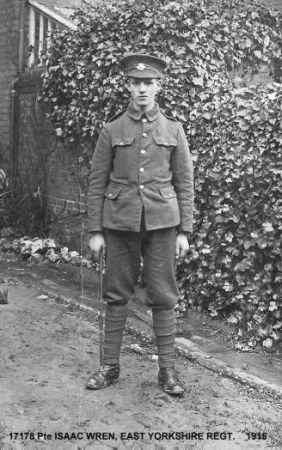
Isaac Wren entered this world at 86 Bolton Street. Workington, on
25th April 1898. the son of John Fisher Wren and Hannah, formerly
Dockray. His father was a furnaceman at the Workington Iron
Works. Isaac was christened on July 3rd of the same year at St
Michael’s Church. Workington.
The life of a furnaceman was not fulfilling for John Wren, and in
1900 he attested as a Constable in the Cumberland &
Westmorland Police Force. And so began the life of a
Policeman’s son for Isaac, and the move every few years to
another Station. A number of years were spent at Ennerdale, where
they remained long enough to have three children born. Isaac
attended the Ennerdale school and was apparently very popular.
His name does not appear in the school Punishment Book. If it
had, his father would have had something to say about it!
He must have inherited his father’s love of nature, as he
won First Prize in the boys (under nine) for the best bouquet of
wild and garden flowers, at Ennerdale Flower Show, in 1905.
A few years were then spent at Eskdale. A place that Isaac did
not like, as evidenced by his letter to his aunt Maggie in 1915!
I suppose it was too remote and not exciting enough for a youth
on the verge of manhood.
In 1913 the family moved to Millom. Isaac obtained work as a
clerk in the offices of the Carlisle Building Society. A clean,
nicely paid job, but maybe a little humdrum for our Isaac! August
1914 brought the start of the Great War. He was still only 16
then but being fairly tall, and probably looking older than he
was, he was confronted by friends and neighbours saying Are you
not going to sign up, a big lad like you ! ” Then one day
at home, probably in a fit of pique at some rebuke or other. he
kicked the back door of the house and said he was going to sign
up. He added at least two years onto his age, went to the Drill
Hall at Millom and enlisted into the Army. He was initially
placed in the Hussars, no. 30212. hut quickly re-assigned to the
8th Battalion, East Yorkshire Regiment, no. 17178. His Army
training was carried out at Halton Park, Tring, Herts. The 21 st
(Yorkshire) Division were the initial occupants. the senior
formation of Kitchener’s Third
New Army. They
trained there from September 1914 to August 1915, when they went
to Aldershot. Isaac had had training on operating the Machine
Gun, most likely a Vickers. He had joined the Machine Gun Section
of the Battalion, the Machine Gun Corps not yet being formed.
This training had most likely been carried out at Belton Park,
Grantham. He wore a proficiency badge on his left forearm.
At 1.1 pm on the 9th September 1915 the Battalion embarked for
France, disembarking at Boulogne. From then until the 25th began
a series of long marches, different billets and bivouacs, and
continued training. On 25th September they reached
Loos-en-Gohelle, a small town in a mining area of French
Flanders. A “big push” had been planned.
The 62nd Brigade War Diary records that the 21st Division was
then attached to the 15th (Scottish) Division and that the 8/East
Yorkshire Regiment was to head the 21 Division as it went into
battle.
The Battalion War
Diary records “ . . . . .at 3pm launched the attack at the
enemy from the BETHUNE - LENS Road. The direction was for Hill
70, through Loos and over the slack heaps.....
The enemy was well prepared however and the Battalion War Diary
records that machine gun tire from Chalk Pit Copse made life very
difficult. “ shells of all classes were falling very thick
around the shelling was incessant Also that rain was falling
throughout the engagement .
During the night a
desperate message was sent back up the line. Enemy shelling
pylons and a good number of machine guns and snipers are worrying
us, unless Artillery help us we shall suffer from heavy
gunfire. Can our Artillery engage enemy ‘s Artillery and
keep down fire, have not enough men to hold position if attacked
at daylight...
And so Isaac Wren came to depart this world on the Loos
Battlefield, 26th September 1915. His body, like thousands of
others, was never found.
His name is recorded among the names of the missing on the Loos
Memorial at Dud Corner Cemetery.

GALLERY